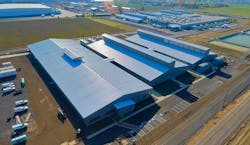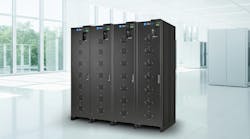The Coop continues to evolve, even under a new brand. The data center design introduced to the world as the Yahoo Computing Coop is now driving the infrastructure growth for Oath, the media properties previously owned by Yahoo and AOL.
The latest version of the Computing Coop just deployed 15 megawatts of capacity on the former Yahoo campus in Quincy, Washington. Oath will soon be building more coops in Lockport, New York as well.
Yahoo introduced the Coop in 2009 after studying the efficient heat management of industrial chicken houses operated by Tyson and other large poultry growers. The first implementation in Lockport broke new ground in data center efficiency, operating at a PUE (Power Usage Efficiency) of 1.08. It was one of the first webscale data centers to be cooled only with fresh air, eliminating the use of power-hungry chillers, using flywheel UPS systems and running entirely by hydro-electric energy.
If you thought that didn’t allow much room for improvement, you’d be wrong.
“There’s been all kinds of tweaks to it,” said Michael Coleman, the Vice President of Infrastructure for Oath. “Each time we build it we iterate, and learn how to do it better. We’ve significantly improved with each generation.”
Building 0n AOL, Yahoo Brands
Oath was formed by Verizon as a holding company for the properties it bought through its acquisitions of AOL and Yahoo, including media brands like TechCrunch, the Huffington Post, Engadget, Tumblr, Flickr, and Yahoo Finance.
The first task was integrating the infrastructure to serve these properties. Oath built its operation around the data center footprint built over 10 years by the Yahoo team.
For many years, Yahoo was one of the Internet’s master builders, deploying server farms far and wide as it built upon its status as a Web pioneer. Alumni of the Yahoo data center team went on to head infrastructure teams at Facebook, Apple and Microsoft. As Yahoo’s business began to struggle and the company explored a sale, the infrastructure team continued to build more capacity, including expansions in Lockport, Quincy and La Vista, Nebraska.
Those former Yahoo campuses provide the foundation for Oath’s infrastructure, along with AOL’s Manassas Tech Center. Verizon will continue to operate its telecommunications business from its existing infrastructure.
Ready for 2 Billion Users
As its brands grow, Oath expects to be supporting 2 billion users by 2020. That’s why Oath is expanding in Quincy, where Yahoo built its first data center in 2007. Yahoo completed the buildout of its original campus, and has expanded on an adjacent property, supported by an 80 megawatt substation providing hydro-electric power from the Grant County Public Utility District (PUD).
The first building is 40 megawatts, and is being built out in phases. That’s one of the refinements in the Computing Coop, which is now in its fourth version.
An aerial view of the Oath campus in Quincy, with the original Yahoo campus at left and the Oath-built expansion on the right. The original campus includes a traditional data center built in 2007, seen behind the first-generation Coops at bottom. (Photo: Oath)
“With our newest design we’ve moved to a highly compartmented construction, so we can add capacity very quickly,” said Coleman. Oath creates computer rooms within each coop that allow them to deploy capacity in 600kW to 4 megawatt increments, which can be completed in six to nine months.
The Coop design treats the entire building as an air handler, with air entering through louvers in the side of the building and being drawn through servers within a hot aisle containment system. The server exhaust exits through a vents in a cupola running along the peak of the sloped roofs.
In Quincy, Oath altered the design by raising the height of the cupola by four feet, which boosted the airflow and allows the Coop to cool higher-density racks. When the design debuted it was cooling 5 kW racks, but the average rack for Oath now draws 15 to 20 kW of power.
“We’ve got a very diverse footprint, with hundreds of applications,” said Coleman.
The newest version of the Coop will soon be deployed a new phase at the data center campus in Lockport, where Oath has land and power commitments to add up to another 40 megawatts of capacity.
“It’s been about a year since we finished our last expansion (in Lockport),” Coleman said. “The newest building will be similar to the one we just building in Quincy.”
Explore the evolving world of edge computing further through Data Center Frontier’s special report series and ongoing coverage.
About the Author



